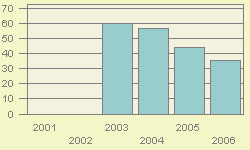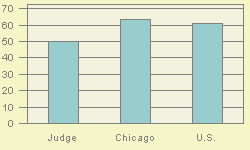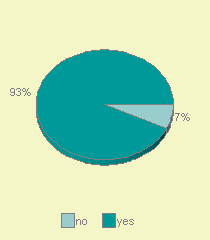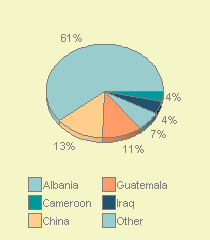Judge Jennie L. Giambastiani
FY 2001 - 2006
Judge Giambastiani was appointed as an Immigration Judge in May 2002. She received a Bachelor of Arts degree in 1983 from Loyola University of Chicago, and a Juris Doctorate from Loyola University School of Law in 1986. Prior to becoming an Immigration Judge, from April 1987 until May 2002, Judge Giambastiani served as district counsel, deputy district counsel, assistant district counsel, and supervisory legalization officer for the former Immigration and Naturalization Service in Chicago. Judge Giambastiani is a member of the Illinois Bar.
Deciding Asylum Cases
Detailed data on Judge Giambastiani decisions are available for the period covering fiscal years 2001 through 2006. During this period, Judge Giambastiani is recorded as deciding 447 asylum claims on their merits. Of these, she granted 218, gave 4 conditional grants, and denied 225. Converted to percentage terms, Giambastiani denied 50.3 percent and granted (including conditional grants) 49.7 percent. Figure 1 provides a comparison of Judge Giambastiani's denial rate fiscal year-by-year over this recent period. (Rates for years with less than 25 decisions are not shown.)
Nationwide Comparisons
Compared to Judge Giambastiani's denial rate of 50.3 percent, nationally during this same period, immigration court judges denied 60.8 percent of asylum claims. In the Chicago Immigration Court where Judge Giambastiani was usually based, judges there denied asylum 63.1 percent of the time. See Figure 2.
Judge Giambastiani can also be ranked compared to each of the 238 individual immigration judges serving during this period who rendered at least one hundred decisions. If judges were ranked from 1 to 238 - where 1 represented the highest denial percent and 238 represented the lowest - Judge Giambastiani receives a rank of 180. That is 179 judges denied asylum at higher rates, and 58 denied asylum at the same rate or less often.
Why Do Denial Rates Vary Among Judges?
Denial rates reflect in part the differing composition of cases assigned to different immigration judges. For example, being represented in court and the nationality of the asylum seeker appear to often impact decision outcome. Decisions also appear to reflect in part the personal perspective that the judge brings to the bench.
Representation
If an asylum seeker is not represented by an attorney, almost all (87%) of them are denied asylum. In contrast, a significantly higher proportion of represented asylum seekers are successful. In the case of Judge Giambastiani, 6.7% were not represented by an attorney. See Figure 3. For the nation as a whole, about 8.2% of asylum seekers are not represented.
Nationality
Asylum seekers are a diverse group. Over one hundred different nationalities had at least one hundred individuals claiming asylum decided during this period. As might be expected, immigration courts located in different parts of the country tend to have proportionately larger shares from some countries than from others. And, given the required legal grounds for a successful asylum claim, asylum seekers from some nations tend to be more successful than others.
For Judge Giambastiani, the largest group of asylum seekers appearing before her came from China. Individuals from this nation made up 13.4 % of her caseload. Other nationalities in descending order of frequency appearing before Judge Giambastiani were: Guatemala (11.2 %), Albania (6.7%), Iraq (4.3%), Cameroon (3.6%). See Figure 4.
In the nation as a whole during this same period, major nationalities of asylum seekers, in descending order of frequency, were China (22.3%), Colombia (10.2%), Haiti (9.9%), Albania (3.9%), Indonesia (3.8%), India (3.5%), Guatemala (3.1%), El Salvador (2.1%), Armenia (2.1%), Mexico (1.7%), Russia (1.6%), Ethiopia (1.6%), Pakistan (1.5%), and Cameroon (1.4%).




